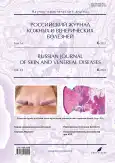Неспецифические адаптационные реакции у амбулаторных пациентов дерматовенерологического профиля
- Авторы: Махнева Н.В.1, Сюч Н.И.2, Кузнецова Н.А.1
-
Учреждения:
- Московский областной клинический кожно-венерологический диспансер
- Военно-медицинская академия имени С.М. Кирова (филиал)
- Выпуск: Том 24, № 6 (2021)
- Страницы: 553-563
- Раздел: ДЕРМАТОЛОГИЯ
- URL: https://journals.rcsi.science/1560-9588/article/view/100773
- DOI: https://doi.org/10.17816/dv100773
- ID: 100773
Цитировать
Аннотация
Обоснование. Изменение лейкоцитарной формулы крови относится к числу важнейших критериев диагностики и прогнозирования течения заболеваний, позволяющих оценить физиологическое состояние организма. Расчётные индексы способны уловить минимальные изменения показателей лейкоцитарной формулы крови на ранних этапах развития патологического процесса и позволяют судить о комплексных изменениях, порой незаметных при клиническом обследовании пациента. Известным методом, характеризующим состояние гомеостаза, является метод оценки состояния гомеостаза по реакциям адаптации, успешно применяемый у пациентов с различной патологией.
Цель ― изучение состояния гомеостаза амбулаторных пациентов дерматовенерологического профиля для оценки степени тяжести заболевания, определения тактики их ведения и дальнейшего лечения.
Материал и методы. Обследована периферическая кровь 58 пациентов дерматовенерологического профиля, в качестве контроля ― периферическая кровь 24 практически здоровых лиц, сопоставимых по возрасту и полу. Общий анализ крови выполняли на аппарате «ABX Micros ES 60» (Франция) наборами этой же компании. Оценка состояния гомеостаза проводилась по реакциям адаптации, определяемым на основании лейкоцитарной формулы крови методом Л.Х. Гаркави и Е.Б. Квакиной (1998). Для повышения диагностической ценности метода одновременно использовали расчётные интегральные гематологические показатели, характеризующие степень выраженности воспалительного процесса, интоксикации, аллергических реакций, а также состояние иммунной системы.
Результаты. У большинства амбулаторных пациентов дерматовенерологического профиля преобладают физиологические реакции адаптации (90%, Z58;0,05=6) преимущественно высоких уровней ― реакции повышенной и спокойной активации (77%, Z40;0,05=12), что свидетельствует о высокой функциональной активности защитно-приспособительных механизмов и сохранности постоянства гомеостаза. У пациентов, записавшихся на амбулаторный приём по поводу проблем со стороны урогенитального тракта, физиологические реакции адаптации наблюдались чаще (95%). В то же время физиологические реакции адаптации у большинства (57%) пациентов проявляли признаки напряжённости, что свидетельствует о нарушении гармоничности и функционирования подсистем организма и снижении уровня реактивности, требующих внимания со стороны лечащего врача при назначении лечения, выборе соответствующего препарата и индивидуальном подборе доз. Признаки напряжённости чаще (67%) наблюдались у пациентов дерматологического профиля. Патологические реакции отмечены у 6 (10%) пациентов и представлены реакциями переактивации (4 пациента), а также острого (1 пациент) и хронического (1 пациент) стресса. Среди пациентов с патологическими реакциями адаптации преобладали лица с заболеваниями кожи.
Заключение. Комплексная оценка состояния гомеостаза по реакциям адаптации и расчётным лейкоцитарным индексам значительно расширяет диагностические возможности клинического анализа крови и позволяет оценить течение, тяжесть воспалительного процесса и эндогенной интоксикации, уровень иммунореактивности организма у амбулаторных пациентов дерматовенерологического профиля.
Полный текст
Открыть статью на сайте журналаОб авторах
Наталия Викторовна Махнева
Московский областной клинический кожно-венерологический диспансер
Автор, ответственный за переписку.
Email: makhneva@mail.ru
ORCID iD: 0000-0001-6238-1804
SPIN-код: 5971-9686
д.м.н.
Россия, 129110, Москва, ул. Щепкина, д. 61/2, стр. 8Наталия Иосифовна Сюч
Военно-медицинская академия имени С.М. Кирова (филиал)
Email: nsyuch@gmail.com
ORCID iD: 0000-0001-7404-8531
д.м.н.
Россия, МоскваНина Александровна Кузнецова
Московский областной клинический кожно-венерологический диспансер
Email: ninamore@mail.ru
ORCID iD: 0000-0001-6998-5360
SPIN-код: 2455-0089
к.м.н.
Россия, МоскваСписок литературы
- Кобец Т.В., Некрасов В.Н., Мотрич А.К. Роль лейкоцитарных индексов в оценке адаптационно-компенсаторных возможностей чукотских детей, больных рецидивирующим бронхитом, на этапе санаторно-курортного лечения // Вестник физиотерапии и курортологии. 2004. Т. 9, № 3. С. 47–48.
- Назаренко Г.И., Полубенцева Е.И., Долгов В.В., Кишкун А.А. Современные технологии повышения эффективности использования возможностей лаборатории // Клиническая лабораторная диагностика. 2004. № 1. С. 52–55.
- Сперанский И.И., Самолейнко Г.Е., Лобачев М.В. Общий анализ крови ― все ли его возможности исчерпаны? Интегральные индексы интоксикации как критерии оценки тяжести течения эндогенной интоксикации, ее осложнений и эффективности проводимого лечения // Здоровье Украины. 2009. Т. 6, № 19. С. 51–57.
- Проскурнина Е.В. Методы оценки свободнорадикального гомеостаза крови: Дис. … докт. мед. наук. Москва, 2018. 221 c.
- Шабалин В.Н., Шатохина С.Н. Морфология биологических жидкостей в клинической лабораторной диагностике // Клиническая лабораторная диагностика. 2002. № 3. С. 25–32.
- Гаркави Л.Х., Квакина Е.Б. Кузьменко Т.С. Антистрессорные реакции и активационная терапия. Москва: ИМЕДИС, 1998. 330 c.
- Бурмасова П.И. Сравнительный анализ лейкоцитарных индексов клеточной реактивности у больных язвенной болезнью ДПК в стадии обострения, ремиссии и здоровых людей // Бюллетень медицинских интернет-конференций. 2016. Т. 5, № 8. С. 1113–1114.
- Гринь В.К., Фисталь Э.Я., Сперанский И.И., и др. Интегральные гематологические показатели лейкоцитарной формулы как критерий оценки тяжести течения ожоговой болезни, ее осложнений и эффективности проводимого лечения // Материалы научно-практической конференции «Сепсис: проблеми діагностики, терапії та профілактики». Харьков, 2006. С. 77–78.
- Гринь В.К., Сперанский И.И., Колесникова Л.И. Показатели гемограммы как критерии оценки тяжести течения ожоговой болезни, ее осложнений и эффективности проводимого лечения // Материалы ІІ Всерос. науч.-практ. конференции «Интенсивная медицинская помощь: проблемы и решения». Новосибирск, 2004. С. 28–29.
- Гусак В.К., Фисталь Э.Я., Сперанский И.И., и др. Оценка тяжести эндогенной интоксикации и выбор метода детоксикационной терапии у обожженных по данным лейкоцитограммы и биохимического мониторинга // Клиническая лабораторная диагностика. 2000. № 10. С. 36.
- Жигулина В.В. Биохимический ответ организма на стресс (обзор литературы) // Верхневолжский медицинский журнал. 2014. Т. 12, № 4. С. 25–30.
- Загорская А.А., Омаров Т.С. Интегральные коэффициенты в оценке степени тяжести больных экземой // Дерматологія та венерологія. 2011. Т. 54, № 4. С. 80–83.
- Кальф-Калиф Я.Я. О лейкоцитарном индексе интоксикации и его практическом значении // Врачебное дело. 1941. № 1. С. 31–35.
- Островский В.К., Родионов П.Н., Макаров С.В. Некоторые критерии в оценке тяжести течения и прогноза при различных формах острого панкреатита // Анестезиология и реаниматология. 2012. № 3. С. 56–59.
- Созарукова М.М., Полимова А.М., Проскурнина Е.В., Владимиров Ю.А. Изменения в кинетике хемилюминесценции плазмы как мера системного окислительного стресса в организме человека // Биофизика. 2016. Т. 61, № 2. С. 337–344.
- Камышников В.С. Справочник по клинико-биохимической лабораторной диагностике: в 2-х томах. Т. 1. Минск: Беларусь, 2000. 495 с.
Дополнительные файлы






